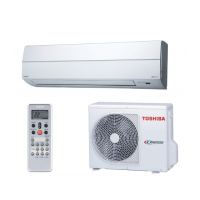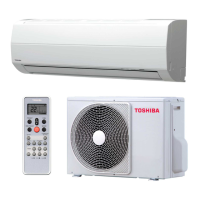7-2-1. Louver control
(1) Vertical air flow louver
Position of veritcal air flow louver is automatically
controlled according to the operation mode.
Besides, position of vertical air flow louver can be
arbitrarily set by pressing [FIX] button.
The louver position which is set by [FIX] button is
stored in the microcomputer, and the louver is
automatically set at the stored position for the next
operation.
(2) Swing
If [SWING] button is pressed when the indoor unit
is in operation, the vertical air flow louver starts
swinging. When [SWING] button is pressed, it stops
swinging.
7-2-2. Indoor Fan Control
The operation controls the fan speed at indoor unit
side. The indoor fan (cross flow fan) is operated by
the phase control induction motor. The fan rotates in 5
stages in MANUAL mode, and in 5 stages in AUTO
mode, respectively. (Table 7-2-2)
1) When setting the fan speed to L, L+, M, M+ or H
on the remote controller, the operation is performed
with the constant speed show in Table 7-2-1
7-2. Outline of Air Conditioner Control
This is a fixed capacity type air conditioner, which uses
a AC motor (18K) and DC motor (24K) for an indoor
circuit is mounted in the indoor unit. And electrical
parts which operate the compressor and the outdoor
fan motor, are mounted in the outdoor unit.
The air conditioner is mainly controlled by the indoor
unit controller. The controller operates the indoor fan
motor based upon commands transmitted by the
remote control and transfers the operation commands
to the outdoor unit.
The outdoor unit receives operation commands
from the indoor unit, and operates the outdoor
fan motor and the compressor.
(1) Role of indoor unit controller
The indoor unit controller receives the operation
commands from the remote control and executes
them.
• Temperature measurement at the air inlet of the
indoor heat exchanger by the indoor
temperature sensor
• Temperature measurement of the indoor heat
exchanger by the heat exchanger sensor
• Louver motor control
• Indoor fan motor operation control
• LED display control
• Transferring of operation commands to the
outdoor unit
• Receiving of information of the operation status
and judging of the information or indication of
error
(2) Role of outdoor unit controller
The outdoor unit controller receives the operation
commands from the indoor controller and
executes them.
• Compressor operation
control
• Operation control of
outdoor fan motor
• Turning off the compressor and outdoor fan
when the outdoor unit receives the shutdown
command
Operations according
to the commands
from the indoor unit
L
L+
M
M+
H
Low
(L + M) / 2
Med
(M + H) / 2
High
Indication
Fan speed
tp the setup temperature, room temperature, and heat
2) When setting the fan speed to AUTO on the remote
controller, revolution of the fan motor is controlled
to the fan speed level shown in Table 7-2-2 according
exchanger temperature.
Table (7-2-1)
H M L L- UL SL
H M L L-
M L L- UL SL
Dry
Fan only
Cooling
OPERATION
MODE
Table 7-2-2 Indoor fan and air flow rate
RAS-18SKPX-V
RAS-18SKPX
FILE NO. SVM-08032
1200
1000
1100
850
1125
950
1025
1050
950
750
1000
850
900
950
850
650
850
750
750
550
700
650
600
450
600
550
500
- 18 -
L+
L+
L+
M+
M+
M+
FAN TAP
UH
fan. The AC motor (18K) and DC motor (24K) drive
rpm
Air flow volume (m
3
/h)
rpm
RAS-24SKP-E
RAS-24SKPX
900
800
700
800
900
RAS-18SKP-E
Air flow volume (m
3
/h)
Model

